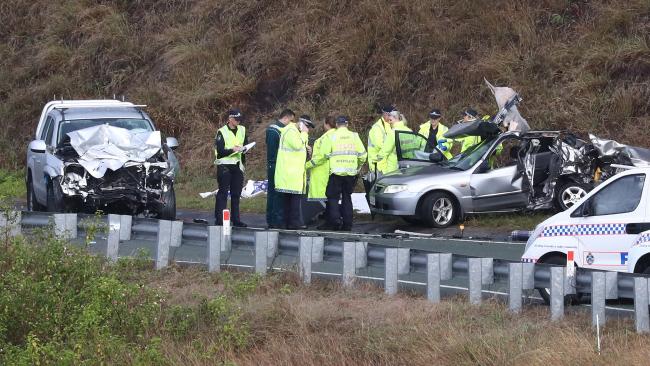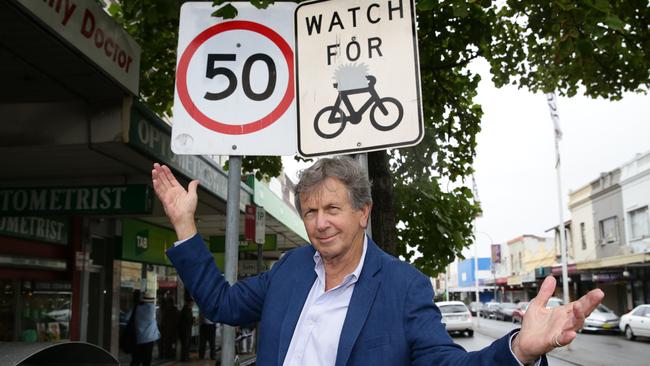Full list: Gold Coast's most dangerous roads revealed
It's been a horror year on Gold Coast roads, with 19 deaths so far. These are the places where most crashes are happening. SEE OUR SUBURB-BY-SUBURB GUIDE
Gold Coast
Don't miss out on the headlines from Gold Coast. Followed categories will be added to My News.
2020 could be one of the most deadly on Gold Coast roads with more than 19 fatalities recorded to date.
Figures from the Australian Road Deaths Database and the Queensland Transport Department reveals the region already sits above the total number of fatalities on the years before, and on par with the highest annual figures back in 2012.
In 2019 the Glitter Strip recorded 13 deaths in the year, 19 in 2018 and 18 in 2017.
In November alone this year three motorcyclists have lost their lives on the Gold Coast roads.

These include the deaths of two motorcyclists in separate crashes on Nerang-Murwillumbah Road (Joshua Mowat) and on Pimpama-Jacobs Well Road (Terry Clark) over the weekend, and the freak accident on the M1 on November 3 which claimed the life of Craig Ward.
The Merrimac man was said to be swerving from debris that fell from the back of a ute when he was hit by a car.
Crashes with multiple fatalities are also behind the significant rate increase.
In August the Upper Coomera community was left grieving when three young people were involved in a horrific two-car crash on Rifle Range Road.
Marnie Zuk, 17, of Loganlea, Jamie Hunter, 21, of Pimpama, and Bryton Thompson, 21, from Loganlea were all travelling in the one car when they slammed into a passing vehicle.
A month earlier the region saw the deaths of four people in their twenties who were killed while travelling on the Nerang-Murwillumbah Road at Advancetown.

The driver of the car that held Brisbane locals Courtney Smith, 20, and Kirsten Van Gorp, 22, Townsville’s Lochlan Parker, 20, and Katrina McKeough, 21, reportedly lost control when it collided with the Volkswagen Amarok ute.
According to statistics the road is among the deadliest in the region, responsible for 17 fatal crashes in the last 20 years (2001-2019).
The hinterland path is only surpassed by major thoroughfares such as the Pacific Motorway, which saw 47 fatal crashes during that period, and Gold Coast Highway with 39.
Beaudesert-Nerang Road ranked fourth with 12 fatal crashes.
Other fatalities include:
A three vehicle crash on Waterford Tamborine Road in early October which claimed the life of a 25 year old man.
Weeks later Casino mother of five Tammara Macrokanis was found dead on the side of the M1 after she was believed to have been fatally struck by a car.
A 93 year old woman died at the scene of a two car crash in Surfers Paradise in March.

Statistics reveal fatalities are most likely to occur on a Sunday, according to Senior Sergeant Brayden Murphy of the Gold Coast District Road Policing Unit, as that is when drivers are most likely to push themselves to fatigue.
“We do see road fatalities come in waves,” he said.
“When you look at an overall trend however we have seen downward trajectory due to a number of things including an increase in enforcement, better car safety features and improved emergency response time.
“You will find on a Sunday we see a lot of motorcyclists on the road, people tend to want to get away and maybe push themselves to drive long distances in a short space of time. That is when fatigue issues really come into it.
“While people have been off the road for some time this year (due to COVID-19 restrictions) we don’t want drivers getting complacent – the risk is still there.
“People need to be aware with the borders being open the usual side of road policing will be in place, we will have high visibility patrols out there and will not be tolerating any anti-social behaviour.”
A majority of fatal local crashes were found to have been at speeds of around 60km an hour.
Number of fatal crashes on Gold Coast roads 2001-2019.
Pacific Hwy - 47
Gold Coast Hwy - 39
Nerang – Murwillumbah Rd - 17
Beaudesert – Nerang Rd - 12
Tamborine – Oxenford Rd -10
Southport – Burleigh Rd -10
Beechmont Rd - 8
Gold Coast – Springbrook Rd - 7
Nerang – Broadbeach Rd -7
Oxenford – Coomera Gorge Rd -6
* Only crash figures counted, single crash may have resulted in multiple fatalities.
Department of Transport and Main Roads Queensland road crash data 2020.
WHERE ARE THE GOLD COAST'S CRASH HOTSPOTS?
THE number of fender benders and fatal crashes on Gold Coast roads has dropped in the past two decades – but the M1 remains a problem area.
But if you drive in Southport north, do the Friday school pick-up or travel the Pacific Highway keep looking in your rearview mirror.
Worst still, a driving instructor says everyone has to look out for the visitors from down south because they can’t chill like lax Queenslanders.
Detailed Queensland Transport and Main Roads data shows 27,267 injury-inflicting crashes were recorded on Gold Coast streets between 2001 and 2018, 380 of which were fatal.
Despite the city’s booming population, the number of accidents dropped by 3 per cent in the 17 years, and fatals by 32 per cent.

MORE NEWS
Surprise candidate announcement: ‘I offer a measured voice’
Chinese developer picks up Southport unit block
‘Child Safety are prepared to let this child die’
But there is a glaring exception — the Pacific Highway. The state’s busiest road had 220 crashes causing injury or death in 2018, a jump of 96 per cent on 2001 figures.
There has been 45 fatal crashes in that time.
Drivers in Southport north are found to be the worst on the Gold Coast. They made up 7 per cent of all recorded incidents in the 17-year period, 1994 in total.
A majority of crashes in the suburb occurred on the Gold Coast Highway (468) and Smith Street connection road (185), followed by Scarborough Street (126).
Merrimac had the lowest number of crashes with just 20 in the 17-year period.

PRINCIPAL PODCAST: SECRET WEAPON BEHIND SCHOOL’S SUCCESS
Drivers seemed to behave their worst on Fridays at school pick-up time with 2459 crashes occurring near 3pm.
Incidents involving pedestrians had also halved, with 73 occurring in 2018, and four pedestrian fatalities.
Pedestrian Council of Australia chairman Harold Scruby said the number of pedestrian incidents on the Gold Coast was still too high for a city of its size.
“When we look at other cities like Oslo in Norway who recorded just one pedestrian death last year, they show it can be done,” Mr Scruby said.
Since 2001, more than 1600 pedestrians were hit and injured by cars, resulting in 78 fatalities.
“Any crash involving a pedestrian is too much.

COAST MYSTERY: THE UNSOLVED CASE OF THE MISSING MEDALS
“Even if you ignore the grief and suffering of those injured, reducing pedestrian injuries just makes financial sense.
“Per annum road trauma costs Australian’s $30 billion, and pedestrians cost twice as much to repair.
“We need to see our cities built around pedestrians instead of cars. That means taking the lead of cities like London and even Manly who have a 30km/h limit in all built-up areas.”
Mr Scruby also advocated for scramble crossings, countdown timers on the wait time at crossing points and safe crossings at roundabouts.
RoadSafe Training owner Chris Staiti, who has worked as a driving instructor for more than 25 years, said he noticed more aggressive behaviour on Gold Coast roads.

“We see more people on the road and infrastructure struggling to keep up,” he said. “I am surprised there aren’t more crashes.
“I am not picking on southerners, but I do find people from NSW and Victoria can be a little bit more aggressive. They have trouble getting used to laidback Queensland driving.”
Mr Staiti said drivers tended to miss common road knowledge like the legal speeds in unmarked areas.
“It is the little things like behaviour at roundabouts and merging also need to be remembered.”


